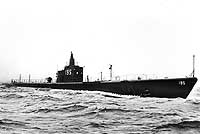
USS Sealion, a 1450-ton Sargo class submarine, was built at Groton, Connecticut. She was commissioned in late November 1939 and, in the spring of 1940, deployed to the Far East to strengthen the defenses of the Philippines as relations with Japan deteriorated. When that nation began the Pacific War on 7 December 1941 (8 December local time), Sealion was at the Cavite Navy Yard, near Manila, undergoing an overhaul. Japanese aircraft raided that facility on 10 December, hitting the submarine with two bombs and killing four of her crewmembers. Sealion was very badly damaged and partially sunk. Since repairs could not be made under the desperate conditions then prevailing in the Philippines, she was stripped of useful equipment and, on 25 December 1941, deliberately wrecked with explosives. The first U.S. Navy submarine lost in World War II, her remains were broken up following the conflict's end.
This page features the views we have concerning USS Sealion (SS-195).
| If you want higher resolution reproductions than the digital images presented here, see: "How to Obtain Photographic Reproductions." |
Click on the small photograph to prompt a larger view of the same image.
|
Photo #: 19-N-20993 USS Sealion (SS-195) Off Provincetown, Massachusetts, during trials, 6 October 1939. Photograph from the Bureau of Ships Collection in the U.S. National Archives. Online Image: 62KB; 740 x 520 pixels Reproductions of this image may also be available through the National Archives photographic reproduction system. |
 |
|
Photo #: SC 130991 Cavite Navy Yard, Philippine Islands Fires at Cavite resulting from the 10 December 1941 Japanese air raid. Barge # 181 (YF-181 ?) -- perhaps visible in the right center -- is loaded with burning torpedos. At the time this photograph was taken, small arms ammunition was exploding in the center of the heavy blaze on the left. The submarine whose bow is visible at the far right is probably USS Sealion (SS-195), which had been hit by bombs and had settled by the stern. Photograph from the Army Signal Corps Collection in the U.S. National Archives. Online Image: 76KB; 740 x 610 pixels Reproductions of this image may also be available through the National Archives photographic reproduction system. |
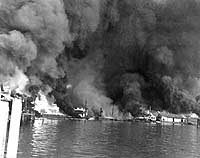 |
|
Photo #: 80-G-243717 Cavite Navy Yard, Philippine Islands Damage to yard facilities from Japanese air attacks. Photographed on 17 December 1941, looking across the Receiving Ship toward the power plant. The remains of the Post Office are in the left foreground, and the bomb-damaged submarine USS Sealion (SS-195) lies across the center of the image. Official U.S. Navy Photograph, now in the collections of the National Archives. Online Image: 133KB; 740 x 620 pixels Reproductions of this image may also be available through the National Archives photographic reproduction system. |
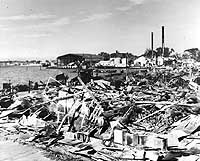 |
|
Photo #: USN 1050058 USS Sealion (SS-195) Wreckage of the submarine, photographed at the Cavite Navy Yard, Philippine Islands, after its capture by the Japanese. Sealion had been fatally damaged by Japanese bombs on 10 December 1941 and was scuttled on 25 December, before U.S. forces abandoned Cavite. Copied from a wartime Japanese publication. Official U.S. Navy Photograph. Online Image: 141KB; 740 x 605 pixels Reproductions of this image may also be available through the National Archives photographic reproduction system as Photo # 428-N-1050058. |
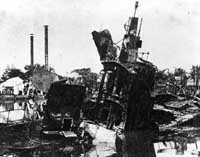 |
|
Photo #: NH 85725 USS Sealion (SS-195) Ship's wrecked hulk at the old Cavite Navy Yard, Philippines, in November 1945. Her conning tower, with periscopes, is at left, with her stern at right. Sealion had been scuttled at Cavite on 25 December 1941, after suffering fatal damage during a Japanese air attack there on 10 December. Photographed by B. Eneberg, who was then navigator of a Royal Australian Air Force PBY-5 aircraft. Courtesy of B. Eneberg, 1977. U.S. Naval Historical Center Photograph. Online Image: 79KB; 740 x 610 pixels |
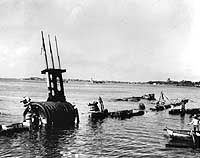 |
| If you want higher resolution reproductions than the digital images presented here, see: "How to Obtain Photographic Reproductions." |
Page made 31 January 2005